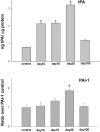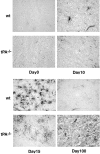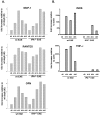Involvement of tissue plasminogen activator in onset and effector phases of experimental allergic encephalomyelitis
- PMID: 12486171
- PMCID: PMC4002885
- DOI: 10.1523/JNEUROSCI.22-24-10781.2002
Involvement of tissue plasminogen activator in onset and effector phases of experimental allergic encephalomyelitis
Abstract
Inflammation, demyelination, and neurodegeneration are pathological features of multiple sclerosis (MS). In the brains of MS patients, tissue plasminogen activator (tPA) mRNA and protein are upregulated, and changes in the levels of tPA correlate with progression of the disease. However, the role of tPA in MS is as yet unknown. tPA functions in the CNS in neuronal plasticity and cell death. tPA also mediates the activation of microglia, the CNS "immune cells." In this study, we establish that tPA activity increases during major oligodendrocyte glycoprotein-induced experimental allergic encephalomyelitis (EAE) in normal mice. To explore the role of tPA in this disease as a model for MS, we have examined the EAE course and expression of histopathological markers in mice lacking tPA (tPA(-/-)). We find that tPA(-/-) mice have a delayed onset of EAE but then exhibit increased severity and delayed recovery from the neurological dysfunction. Demyelination and axon degeneration are delayed, microglial activation is attenuated, and the production of chemokines is decreased. Our results suggest that tPA and activated microglia have complex roles in MS/EAE, and that these roles are harmful during the onset of the disease but beneficial in the recovery phase. A temporally restricted attenuation of tPA activity could have therapeutic potential in the management of MS.
Figures







Similar articles
-
Modulation of microglial/macrophage activation by macrophage inhibitory factor (TKP) or tuftsin (TKPR) attenuates the disease course of experimental autoimmune encephalomyelitis.BMC Immunol. 2007 Jul 16;8:10. doi: 10.1186/1471-2172-8-10. BMC Immunol. 2007. PMID: 17634104 Free PMC article.
-
A role for the plasminogen activator system in inflammation and neurodegeneration in the central nervous system during experimental allergic encephalomyelitis.Am J Pathol. 2005 Aug;167(2):545-54. doi: 10.1016/S0002-9440(10)62996-3. Am J Pathol. 2005. PMID: 16049338 Free PMC article.
-
Role of tissue plasminogen activator in clinical aggravation of experimental autoimmune encephalomyelitis and its therapeutic potential.Cell Immunol. 2020 Feb;348:104040. doi: 10.1016/j.cellimm.2020.104040. Epub 2020 Jan 10. Cell Immunol. 2020. PMID: 31955841
-
Tissue plasminogen activator as a key effector in neurobiology and neuropathology.Biochem Soc Trans. 2002 Apr;30(2):183-9. Biochem Soc Trans. 2002. PMID: 12023848 Review.
-
Clinical implications of the involvement of tPA in neuronal cell death.J Mol Med (Berl). 1997 May;75(5):341-7. doi: 10.1007/s001090050119. J Mol Med (Berl). 1997. PMID: 9181475 Review.
Cited by
-
Nicotine modulates neurogenesis in the central canal during experimental autoimmune encephalomyelitis.Neuroscience. 2015 Jun 25;297:11-21. doi: 10.1016/j.neuroscience.2015.03.031. Epub 2015 Mar 23. Neuroscience. 2015. PMID: 25813705 Free PMC article.
-
Tissue plasminogen activator prevents white matter damage following stroke.J Exp Med. 2011 Jun 6;208(6):1229-42. doi: 10.1084/jem.20101880. Epub 2011 May 16. J Exp Med. 2011. PMID: 21576385 Free PMC article.
-
Breaking boundaries-coagulation and fibrinolysis at the neurovascular interface.Front Cell Neurosci. 2015 Sep 16;9:354. doi: 10.3389/fncel.2015.00354. eCollection 2015. Front Cell Neurosci. 2015. PMID: 26441525 Free PMC article. Review.
-
The changing phenotype of microglia from homeostasis to disease.Transl Neurodegener. 2012 Apr 24;1(1):9. doi: 10.1186/2047-9158-1-9. Transl Neurodegener. 2012. PMID: 23210447 Free PMC article.
-
Modulating the delicate glial-neuronal interactions in neuropathic pain: promises and potential caveats.Neurosci Biobehav Rev. 2014 Sep;45:19-27. doi: 10.1016/j.neubiorev.2014.05.002. Epub 2014 May 10. Neurosci Biobehav Rev. 2014. PMID: 24820245 Free PMC article. Review.
References
-
- Akenami F, Koskiniemi M, Mustjoki S, Siren V, Farkkila M, Vaheri A. Plasma and cerebrospinal fluid activities of tissue plasminogen activator and urokinase in multiple sclerosis. Fibrinolysis Proteolysis. 1997;11:109–113.
-
- Akenami F, Siren V, Wessman M, Koskiniemi M, Vaheri A. Tissue plasminogen activator gene expression in multiple sclerosis brain tissue. J Neurol Sci. 1999;165:71–76. - PubMed
-
- Andrade-Gordon P, Strickland S. Interaction of heparin with plasminogen activators and plasminogen: effects on the activation of plasminogen. Biochemistry. 1986;25:4033–4040. - PubMed
Publication types
MeSH terms
Substances
Grants and funding
LinkOut - more resources
Full Text Sources
Other Literature Sources
Molecular Biology Databases
